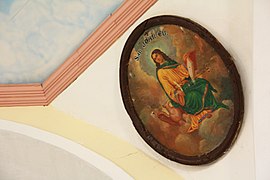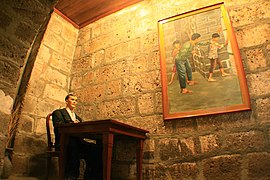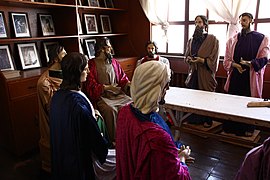
Bulacan is a province in the Philippines located in the Central Luzon region. Its capital is the city of Malolos. Bulacan was established on August 15, 1578, and part of the Metro Luzon Urban Beltway Super Region.
Padre Dámaso Verdolagas is a fictional character in the novel Noli Me Tángere. The novel was written by José Rizal, one of the leaders of the Propaganda Movement in the Philippines. Noli Me Tángere is a controversial and anticlerical novel that exposed the abuses committed by the Spanish friars and the Spanish elite in colonial Philippines during the 19th century.

Noli Me Tángere, Latin for "Touch me not", is an 1887 novel by José Rizal during the colonization of the Philippines by the Spanish Empire to describe perceived inequities of the Spanish Catholic friars and the ruling government.

El filibusterismo, also known by its alternative English title The Reign of Greed, is the second novel written by Philippine national hero José Rizal. It is the sequel to Noli Me Tángere and, like the first book, was written in Spanish. It was first published in 1891 in Ghent.

Paete, officially the Municipality of Paete, is a 4th class municipality in the province of Laguna, Philippines. According to the 2015 census, it has a population of 25,096 people.

San Ildefonso, officially the Municipality of San Ildefonso is a 1st class municipality in the province of Bulacan, Philippines. According to the 2015 census, it has a population of 104,471 people.

San Rafael, officially the Municipality of San Rafael, is a 1st class municipality in the province of Bulacan, Philippines. According to the 2015 census, it has a population of 94,655 people.

The Obando Fertility Rites are a dance ritual, initially an Anitist ritual, and later also became a Catholic festival celebrated every May in Obando, Bulacan, Philippines. Locals and pilgrims, sometimes dressed in traditional costume, dance and sing in the town's streets to honour and beseech Obando's three patron saints: San Pascual, Santa Clara and Nuestra Señora de Salambáo.

Joaquín González y Lopez was a Filipino politician and a member of the Malolos Congress that wrote the Malolos Constitution, the first Philippine constitution, after the country declared independence from Spain in 1898. He was one of two elected delegates representing the province of Pampanga, the other being Jose Rodriguez Infante. Along with Felipe Calderon y Roca, the main author of the constitution, Dr. González was part of a committee that took part in the debates that went article by article from October 25 to November 29, 1898.

The Parish of San Pascual Baylon and National Shrine of Nuestra Señora Inmaculada Concepcion de Salambao(Tagalog: Parokya ni San Pascual Baylon at Pambansang Dambana ng Nuestra Señora Inmaculada Concepcion de Salambao), also known as Obando Church, is a Roman Catholic church located in the municipality of Obando in the province of Bulacan, Philippines. Founded by Franciscan missionaries, under the Spanish flag, it is the venue of the three-day Obando Fertility Rites held annually in honor of three patron saints, namely: St. Pascual Baylon, St. Claire of Assisi and Our Lady of Salambao, a celebration that was mentioned by Jose Rizal, the Philippine national hero, in the pages of his Spanish-language novel, the Noli Me Tangere. During the month of May, parishioners and other devotees perform the three-day Obando Dance inside the church, followed by a street procession.
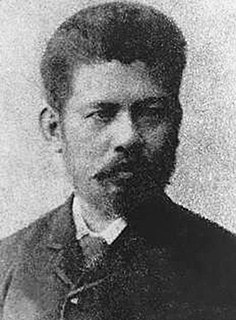
Marcelo Hilario del Pilar y Gatmaitán, commonly known as Marcelo H. del Pilar and also known by his pen name Plaridel, was a Filipino writer, lawyer, journalist, and freemason. Del Pilar, along with José Rizal and Graciano López Jaena, became known as the leaders of the Reform Movement in Spain.
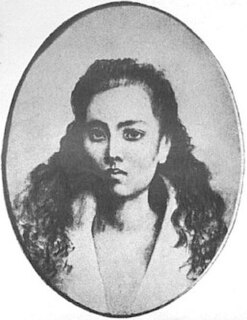
María Clara, whose full name is María Clara de los Santos, is the mestiza heroine in Noli Me Tángere, a novel by José Rizal, the national hero of the Republic of the Philippines. Her name and character has since become a byword in Filipino culture for the traditional, feminine ideal.
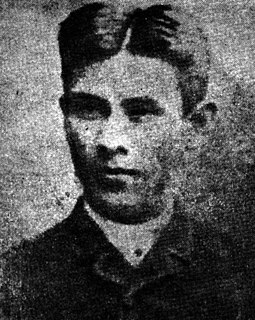
Máximo Viola y Sison was a propagandist, writer, revolutionary leader and doctor from Bulacan, Philippines.
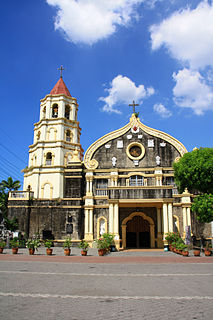
Santiago Apostol Church, also known as Plaridel Church or Quingua Church, is a 15th-century Roman Catholic Church under the patronage of Saint James the Apostle and is located along Gov. Padilla street, Brgy. Poblacion, in Plaridel, Bulacan, Philippines. In 1961, a historical marker was installed on the church by the National Historical Committee.

The San Miguel Arcangel Parish Church,is a 19th-century, Baroque church located along De Leon St., Brgy. Poblacion, San Miguel, Bulacan, Philippines. The parish church, with Saint Michael, the Archangel as patron saint, is under the jurisdiction of the Roman Catholic Diocese of Malolos.
This is the timeline of the Philippine Revolution. It contains the events before and during the revolution.

The Battle of San Rafael fought between Filipino revolutionaries under the leadership of Anacleto “Matanglawin” Enriquez against the Spanish army headed by Commandant Lopez Arteaga. On their way from the town of Paombong, Bulacan to the mountain ranges of Bulacan, General Isidoro Torres of Malolos decided to divide the troop of Katipuneros into two: one group under his supervision while the other under the guidance of General Enriquez and his brother Colonel Vicente Enriquez. The group of General Enriquez was supposedly heading to the town of Baliuag, Bulacan but decided to stay instead in San Rafael, believing it to be a strategic site. Unknowingly, a Spanish troop from Manila heading towards San Rafael, prepared to silence the Filipino insurgents. The battle started at around 7 a.m. on November 30, 1896. The Spanish forces were so strong that General Enriquez ordered a retreat to the San Rafael. Sometime in the middle of the battle, some of the Filipino troops including Colonel Enriquez were separated from the rest of the group and headed to the town of Bigaa. At around noon, the Spanish army forced the church doors open and murdered the Filipino revolutionaries seeking shelter in the church. It is estimated that nearly 800 people were killed in the battle, most of whom were children and other locals. The number of casualties was so immense that it was believed that blood spilled in the church reached ankle-deep. The gobernadorcillo of San Rafael ordered a mass grave to be made near the church. It is believed that the Battle of San Rafael inspired the young general Gregorio Del Pilar to join the revolution against Spain.

Noli Me Tangere is an opera in 3 acts by Felipe Padilla de León with libretto by Guillermo Tolentino. The opera was closely based on a novel by José Rizal by the same name. The opera was sung entirely in Tagalog and is considered as the first full-length Filipino opera.
Philippines National Historic Landmarks is a registry of historic sites in the Philippines that have been officially declared by the Philippine Registry of Cultural Property.




